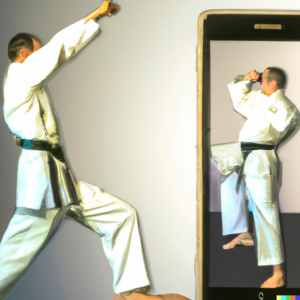Elevating Karatedō Practice: Mirror vs. Video for self-training
All Gojuryu Network (www.gojuryu.network) & SKSV (Gojuryu.net) cross-post
By Johnpaul Williams – March 27, 2023
Introduction
In the sacred space of Karatedō practice at home, the choice between using a traditional mirror or embracing modern video recordings as training aids sparks a fascinating debate. In this exploration, we briefly delve into the nuances of both methods, unraveling the complexities and uncovering the transformative potential each brings to the practitioner’s journey.
The Mirror’s Deception

What you see in the mirror is not always what the camera captures
The mirror, a stalwart companion in many training spaces, offers immediate feedback to Karatedō practitioners. However, its deceptive nature introduces a unique challenge. As movements unfold, the mirrored image intertwines with the practitioner’s perception, potentially creating a disconnect between observation and external reality. For instance, a punch to the chest may manifest as to the shoulder in the mirror due to depth perception, adding a layer of complexity to the evaluation of technique.
Video Recordings: A Technological Paradigm Shift
Enter the era of pocket supercomputers, residing within our smartphones. Capable of capturing high-definition video recordings, this technological evolution revolutionizes self-analysis. Unlike the mirror, video recordings produce a faithful, non-mirrored representation of the practitioner’s performance. When scrutinized on a larger screen, the recorded footage unveils a truer image, allowing for a detailed examination of form, technique, and precision.
Comparative Analysis: Learning from the Masters
The benefits of video recordings extend beyond immediate correction. They open the door to a comparative analysis, a powerful tool for growth. By juxtaposing one’s performance against seasoned Karateka, practitioners discern nuances, identify areas of improvement, and set realistic benchmarks for progress. This visual dialogue with experienced practitioners, facilitated by video recordings, transforms the learning process into a dynamic and interactive experience.
Dynamic Insights through Video Review
The dynamic nature of video recordings unfolds during the review process. The ability to play back footage in slow motion or frame-by-frame provides a granular understanding of each movement. This feature becomes particularly valuable when assessing depth, distance, and the fluidity of transitions between techniques. Unlike the static two-dimensional reflection in a mirror, video recordings capture the essence of movement in three dimensions, offering a comprehensive and multi-angled perspective.
Recording Progress: A Chronicle of Growth
Beyond the immediate training session, recorded practice sessions become a chronicle of the practitioner’s journey. This recorded history serves as a motivational tool, allowing individuals to witness the evolution of their skills over time. Setting goals, informed by insights gained through video analysis, becomes a tangible and rewarding aspect of the ongoing practice routine.
Conclusion: The Fusion of Tradition and Technology
In essence, while mirrors provide instantaneous feedback, video recordings emerge as an indispensable and transformative tool for elevating Karatedō practice. The fusion of technology and martial arts not only accelerates progress but also enriches the journey toward mastery, making each training session a profound exploration of technique, self-discovery, and continuous improvement. Choose wisely, for in this debate lies the key to unlocking your full potential in the art of Karatedō.
